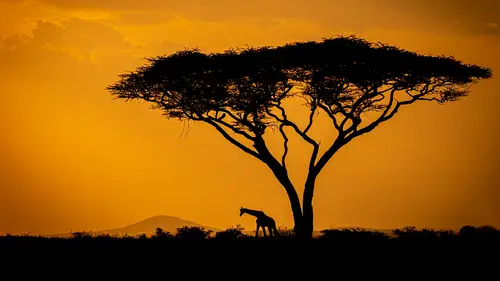The Elements of Design
Lesson 22 from: Mastering Photographic Composition and Visual StorytellingChris Weston

The Elements of Design
Lesson 22 from: Mastering Photographic Composition and Visual StorytellingChris Weston
Lessons
Your 10,001st Photograph
03:24 2Camera Gear
03:03 3Piece of Gear We Always Forget
03:47 4Be a Storyteller
03:09 5Finding Ideas For Photography - Know Your Subject
06:59 6Cae Study - Why Are Zebras Black and White Striped
01:30 7Photograph What You Love
02:00 8See the Extraordinary in Ordinary Things
01:31Have an Opinion
01:46 10See With a Child’s Eyes
02:34 11Tell Your Story
08:46 12Find a Needle in the Haystack
01:38 13Lions Hunting Under Star Trails
04:21 14Ansel Adams and Visualisation in Practice
03:20 15Keeping an Open Mind and Thinking on Your Feet
02:47 16Case Study - The Maternal Bond
02:42 17Don’t Tell the Same Old Story
02:38 18Relevance
01:06 19#1 Reason Photographs Fail
02:57 20Getting Rid of Clutter
03:59 21Post Capture Cropping
02:04 22The Elements of Design
02:31 23Elements of Design
01:38 24Elements of Design - Shape
02:21 25Case Study - Shape
02:11 26Elements of Design - Color
01:55 27Case Study - Color
01:50 28Color in Camera
01:42 29Pattern
01:54 30Texture
02:24 31Seeing The Elements of Design
08:52 32Gestalt Theory
05:10 33Case Study - Cove
01:36 34Case Study - Hat
02:09 35Light and Contrast
01:54 36Light and Form
01:26 37Light and Depth
03:48 38Perspective
02:28 39Lenses and Perspective
02:47 40Rule of Thirds
02:48 41Centre of Frame
01:36 42Case Study - Positioning the Subject
01:48 43Positioning the Subject - Dynamic Symmetry
03:20 44The Horizon Line
02:52 45Should the Horizon Line Always be Straight and Level
02:13 46Other Lines
04:57 47Rhythm, Balance, and Visual Weight
02:59 48Negative Space
02:29 49The Two Most Important Controls on Your Camera
03:41 50Training the Mind
04:26Lesson Info
The Elements of Design
look closely at a leaf, any leaf, and you'll see the five basic elements of design, line, shape, color, pattern and texture. Everything on Earth, whether made naturally or built by humans or human program machines, is composed of one or more of these elements. Line, shape, color, pattern and texture of the building blocks of any photograph they communicate, meaning they suggest appearance. And they evoke both emotional and physiological reactions in the viewer in composition There, the visual tools you used to tell your story, and so part of your role in becoming the complete photographer is to become fluent in this secret language of design. Line is the most basic element of design is also the most powerful and complex lines could be straight, diagonal or curved. They can radiate, repeat, run, parallel or converge, leading you into the picture space or out of it. Line's gonna be implicit, like the horizon or implied, which is an imaginary line that is formed in the mind between two se...
parate points. As you can see, there is far more tow line than necessarily meets the eye. Horizontal lines imply space. They lead the viewers eyes across the frame, typically from left or right, because in the West that's the way we've been programmed to read with a calm, tranquil energy so calm, in fact, that objects placed on the horizontal line will appear static. Vertical lines, on the other hand, accentuate height and imply solidity and strength. They leave the eye from the foot of the image upwards diagonal lines a dynamic and create energy, unlike the horizontal gravity, now plays a part in stirring our physiological response to the visual. Curved lines also create visual energy, but the implied flow is less dramatic than the diagonal, which makes the suggested movement. Comma thin lines can imply contrast. Thick lines may denote shadow. Both imply depth, as do converging lines. As you can see, Line is a powerful, elemental photographic tool. Now I explained much more about the practical use of line in composition in Module seven. First, though I want to take you from the racing English coast to the heat of Marrakech. I don't know
Ratings and Reviews
Edmund Cheung
Perhaps the style of presentation and simple, short, and direct messaging does not "jive" with some; but others may really love this. Yes the production of each episode is stylized and perhaps a bit formal (like a TV Show?), but there is something to be said about it. Perhaps this is not meant for professional photographers? I think of myself as decent amateur / high level photographer. I found lots of great nuggets of wisdom and inspiration from this. Especially when I an in a rut for creativity. Yes I have heard all these concepts and ideas before. BUT it is always great to hear and see a different way of presentation and voice. Please do NOT take the naysayer reviews as the end all. You should judge for yourself and watch a few episodes. If the style and content click for you, I would highly recommend this course.
Abdullah Alahmari
Thanks a lot to mr. Chris Weston This course is great and It is a 🌟 🌟 🌟 🌟 🌟 course for me. Beside the other course ( mastering the art of photography ) both courses are Complementing to each other and highly recommended.
Kai Atherton
While I am perhaps more advanced in my photography then this course. It is always great to be able to go back to fundamentals and remind ourselves of the basic principles, and even camera function. I thoroughly enjoyed this course and Chris's other. It is a great motivational jumpstart when lacking fresh creative idea's.
Student Work
Related Classes
Beginner